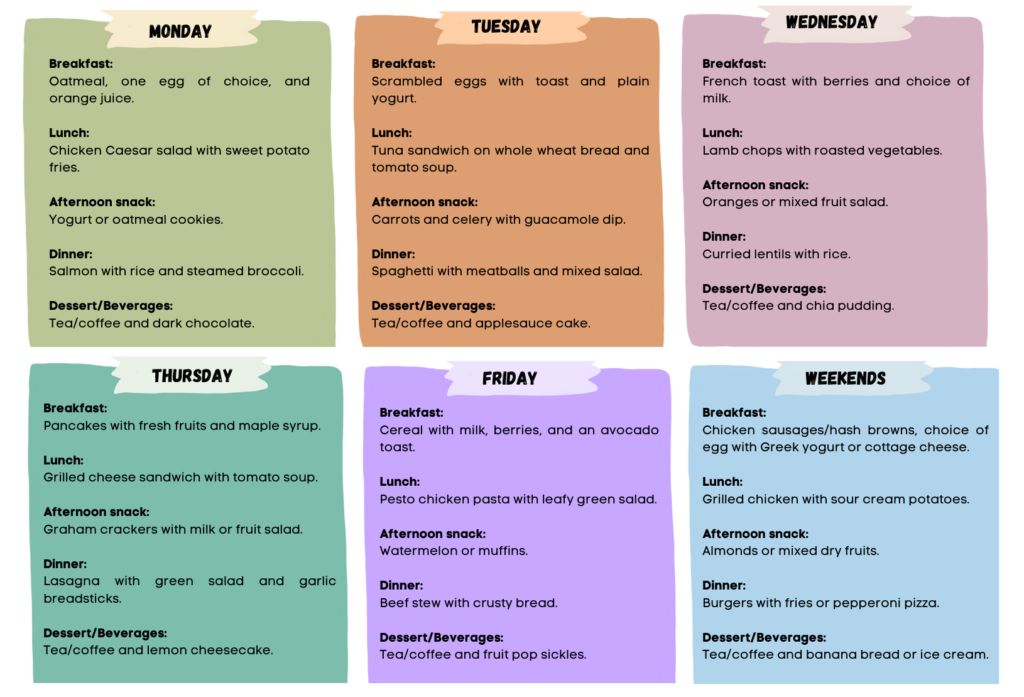For the last few weeks, I have been quite absorbed in my aunt’s Facebook posts about her nursing home food. At times, they are witty, full of her dry humor, and sometimes, they are pretty intriguing, even concerning. So, after closely observing her social media posts, I decided to talk to her and do some independent research to get a better idea about the nursing home food service.
In this blog, we will discuss the various food options in nursing homes. Besides, we will provide a sample food menu in long-term care facilities and the dietary regulations set by the CMS. Finally, we will share some exciting nursing home menu ideas to add some spice to the regular meal plans. So, let’s dig in!
Do all nursing homes provide food?
Generally speaking, most nursing homes provide meals for residents. The menus are designed to offer a nutritionally balanced and varied selection of meals that meet the needs of the elderly population. The food served in nursing homes typically features dishes that are easy to chew, digest and swallow.
The menus for nursing homes may vary depending on the specific facility. The reasons behind this are budget constraints, facility size, availability of resources, staff ratio, and other related factors.
Nursing home food: what are the dining options?
So, after a long chat with my aunt, I looked into the different meal services and dining options provided by nursing homes. They usually provide institutional food, with a weekly nursing home menu. But long-term care homes have diverse dining options available depending on the residents’ needs and facility resources. So, let’s take a look at some of the dining options at nursing homes.
1. Restaurant-style dining
Restaurant-style dining in nursing homes allows residents to choose when and what they eat. It gives them a sense of independence, autonomy, and control over their lives. In addition, it is an excellent opportunity to socialize with fellow nursing home residents. Such settings promote mental stimulation and enhance cognitive functioning among the elderly.
2. Room service
Another dining option at nursing homes is to have your meals delivered to your room. This service is especially beneficial for the elderly with disabilities, recovering from a surgery, or other mobility issues. This type of meal delivery also helps reduce the risk of falls and other types of accidents that can occur when seniors move around the facility.
3. Family-style dining
Family-style dining is another nursing home dining option that is getting traction these days. It is just like traditional family dining, where all residents sit at large dining hall tables and have their meals together. This type of dining helps create a sense of community amongst elderly individuals and reduces isolation and loneliness.
4. Special dietary options
Many nursing homes offer specialized dietary plans for those residents with special dietary needs or restrictions, such as gluten-free, dairy-free, vegan or specific diets for patients with memory problems. A dietitian checks these menus for nursing homes to ensure they meet each resident’s dietary requirements and provide adequate nutrition.
5. Food delivery services
Some facilities also allow food delivery to nursing homes. It has become increasingly popular in the past few years due to Covid-19 and otherwise, as they provide a convenient and safe way to have meals delivered to the doorstep. But it is to be noted that there are some drawbacks of such food delivery to nursing homes as these meals often lack proper nutritional value. So, most nursing homes regulate outside food delivery to meet residents’ dietary needs.
Elderly nursing home food menu sample
Nursing homes typically provide a variety of meal options for their residents. Generally, they offer three meals a day as well as snacks, with menus that are geared towards the nutritional needs of older adults. Below we will see a typical nursing home food menu sample.
Food Group 1: Grains
Grains are usually the key source of a hearty, nutritious breakfast, and it’s no different when it comes to nursing home food menu. It consists of freshly baked bread, oatmeal, waffles, pancakes, French toast, pasta, porridge, quinoa, etc. These food items provide the necessary fiber, calcium, and minerals to boost the energy levels of older adults.
Food Group 2: Protein
Nursing home meals must have enough protein in their daily and weekly menus. Some protein-rich foods served at long-term facilities include eggs, sausages, beans, steaks, grilled chicken, fish, nuts, etc. These food items help seniors maintain muscle mass, increased immune functions, and better cardiovascular function.
Food Group 3: Fruits & Vegetables
Nursing homes serve fresh fruits and vegetables every morning or afternoon to ensure residents get their daily dose of vitamins and minerals. Fruit options may include bananas, oranges, mangoes, watermelon, or jams prepared from seasonal fruits. In addition, leafy vegetables such as spinach, kale, cabbage, broccoli, brussels sprouts are high in omega-3 fatty acids and highly beneficial dementia foods.
Food Group 4: Dairy
Dairy is another essential food component of nursing home foods. Milk, cheese, butter, yogurt, and pudding, cakes, are all great sources of calcium, vitamin B12, Zinc, and protein. For older adults who have dietary restrictions such as lactose intolerance are provided with alternatives such as almond milk, lactose-free yogurts, etc.
Food Group 5: Snacks
Apart from the three regular meals, nursing homes usually provide light snacks to each resident. That may include soups, salads, yogurt, nuts, crackers, ice creams, or muffins. Snacks are an essential part of the care and nutrition that residents receive and add variety to the diet. In addition, snack time is a great way to bring people together and promote quality of life amongst the residents.
Food Group 6: Beverages
Nursing home beverage options provide elderly residents with some refreshments and help them stay hydrated. The type of beverages available to residents typically depends on the facilities’ policies, dietary restrictions, and preferences of each resident. But the common beverages usually include water, juices, coffee, tea, milk, and shakes. Depending on the particular facility, nursing home beverage options may also have daily specials or seasonal treats.
Weekly nursing home menu sample
Nursing homes usually create a personalized menu that meets the needs and preferences of the residents. Here are some weekly nursing home menu examples:

Nursing home food
Emergency menu plan nursing home
In emergency situations, such as when there is limited access to fresh ingredients or cooking facilities, it’s essential to have a menu plan that focuses on providing nutritious and shelf-stable meals. Here’s an example of an emergency menu plan for a nursing home:
Breakfast:
- Instant oatmeal packets with milk or water
- Individual yogurt cups
- Pre-packaged fruit cups or canned fruits (in juice or light syrup)
- Pre-packaged breakfast bars or granola bars
- Bottled water or juice boxes
Lunch:
- Ready-to-eat sandwiches (such as turkey or ham) with individually packaged condiments
- Pre-packaged salads (e.g., Caesar salad, garden salad)
- Canned soups (low-sodium options if available) with crackers or bread
- Individual packets of peanut butter and jelly with bread or crackers
- Bottled water or juice boxes
Dinner:
- Canned chili or beef stew (low-sodium options if available) with crackers or bread
- Canned vegetables (e.g., green beans, corn, peas)
- Pre-packaged macaroni and cheese cups
- Instant mashed potatoes
- Fruit cups or canned fruits (in juice or light syrup)
- Bottled water or juice boxes
Snacks:
- Individual packets of nuts or trail mix
- Granola bars or energy bars
- Fresh fruits that don’t require refrigeration (e.g., apples, oranges, bananas)
- Individual packets of crackers or rice cakes
- Bottled water or juice boxes
It’s crucial to regularly check and rotate the emergency food supplies to ensure they are within their expiration dates. Additionally, consider having a backup generator or alternative cooking methods (e.g., camping stoves) to provide hot meals. Communication with local emergency services and authorities is also essential to ensure the safety and well-being of the residents during emergencies.
What are some exciting nursing home menu ideas?
It is very much possible to make nursing home menus exciting and nutritious at the same time. Below are some exciting nursing home menu ideas that can bring some joy and cheer into the lives of older adults in nursing homes.
1. Create themed menus
Have a themed food day every week to add some variety. For example, a Mexican night with tacos and burritos, an Italian night with pasta dishes, or an Asian Fusion night with stir-fried dishes. Additionally, involve residents in deciding what goes on their menus so that it keeps them engaged and excited about their meals.
2. Introduce combo meals
Another way to keep things interesting is by providing choices for combo meals. For instance, a combination plate could include a savory protein such as grilled chicken or fish, along with roasted vegetables like potatoes, green beans, or mashed potato. This way, residents can choose the combination they prefer.
3. Offer seasonal produce
Offering seasonal produce can add variety to nursing home food while also introducing fresh flavors from local farmers or vendors. Some facilities also have their own gardens where they produce vegetables and fruits. Seniors who love gardening, could also take advantage of these community gardens and do some light work such as helping the staff pick fruits and veggies. It can do wonders for their mental and physical health!
4. Incorporate special occasion menu
Finally, incorporating special occasion menus during holidays, or events could bring cheer and festivity to the facility. For example, serving turkey and cranberry sauce during Thanksgiving, eggnog and holiday cookies during Christmas, or a Fourth of July barbecue with hamburgers and hot dogs. It’d also allow residents to bond with their peers over food while enjoying some movies, music, or games!
What are the CMS dietary regulations for nursing homes?
Centers for Medicare & Medicaid Services (CMS) dietary regulations for nursing homes are a comprehensive set of standards that all long-term care facilities must maintain. These regulations are designed to ensure residents receive balanced, nutritious meals that meet individual needs. Here are the CMS dietary regulations:
- The facility must have a dietary manager or food service manager with appropriate licensing and qualifications.
- Meal plans must meet all recommended nutrient levels for calories, protein, vitamins and minerals.
- All meals should be prepared with fresh ingredients to preserve nutritional value and should be served in an appetizing manner.
- Must provide at least three meals every day.
- Residents’ food preferences must be taken into consideration.
- Food menu must consider any allergies, intolerances, as well as residents’ ethnic or religious factors while creating meal plans.
- Proper food handling and hygiene techniques must be followed while preparing and serving food.
- Necessary provisions or assistive devices must be arranged for residents unable to eat independently.
- Appropriate storing, distributing, and serving measures must be in place for food and ingredients.
- A registered dietitian must check and approve all menus before they are implemented to ensure CMS nutrition guidelines are being followed.
3-points summary
- All nursing homes are required to provide nutritious, balanced meals at least three times a day.
- There are several dining options available in nursing homes, including room service for disabled or frail individuals.
- All long-term care facilities must adhere to CMS’s dietary regulations to ensure adequate nutrient levels and safety protocols are being met.
Final thoughts
Good food and dining options are crucial to improve mood, boost energy levels, and promote socialization among nursing home residents. All too often, we hear stories of dissatisfaction with nursing home food from residents (like my aunt). It primarily happens due to lack of variety, not considering residents’ preferences, and lack of resources. But with a little creativity and effort, however, nursing homes can provide their residents with appealing and nutritious meals.
We hope this blog provided insights into the dining and food options available in nursing homes. Also, if you are moving to a care facility, make sure you check whether they are following the nutrition guidelines laid out by CMS. If you would like more information about finding the right nursing home for your loved one, please contact us today!
FAQs
- Can you do food delivery to nursing homes?
Yes, it is possible to do food delivery to nursing homes. For example, restaurant delivery services such as Uber Eats and DoorDash can deliver food directly to a senior living facility. Sometimes, residents’ families can deliver home-cooked meals to nursing homes. However, each facility has their set of rules and regulations, so make sure you check with a staff before ordering or delivering food!
- Can you get food stamps while in nursing home?
Generally, the use of food stamps or Supplemental Nutrition Assistance Program (SNAP) while in a nursing home is not allowed. Since it is a form of assistance and nursing homes typically provide regular meals, they do not qualify for that support.
- Why is nursing home food so bad?
Unfortunately, there are many complaints about nursing home and assisted living food. The main reasons behind this dissatisfaction could include:
- Lack of variety in food menu
- Insufficient facility budget
- Lack of quality chefs/staff
- Scarcity of ingredients and resources
- Outdated menu planning techniques
- What is the average nursing home food cost?
The average cost of nursing home food varies depending on the region and facility in question. Generally speaking, on average, it costs around 6 to 10 USD per resident in a single day.

